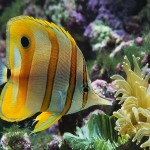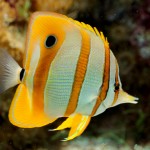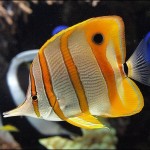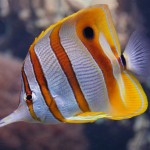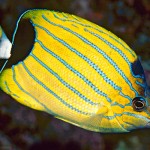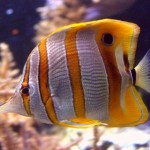Butterfly fish are striking marine animals found in the reefs of the Pacific, Indian, and Atlantic Oceans. They look like small Angelfishes but they do not possess spines at their gill covers.
It is interesting to know that the fossil record of butterfly fish is marginal. Due to their restricted habitat (coral reefs), it is believed that scavengers must have dispersed their remains which will be overgrown by corals and eroded.
A fossil (Pygaeus) was however discovered and traced to the Bartonian era (40 - 37 million years ago).
Facts :
There are several interesting facts to know about butterfly fish. Butterfly fish are known to possess sizes ranging from 3 – 7 inches but it will surprise you to know that some species are known to grow up to 9 inches.
Also, they are called butterfly fish because of their conspicuous and attractive coloration, and are known to come in different colors like white, red, yellow, silver, black and orange with lots of patterns and spots on their bodies.
Furthermore, around their eyes, they possess black stripes and also spots on their bodies. These stripes and spots tend to help them escape from their predators.
Diet :
Butterfly fishes are generally diurnal. This means that they feed during daylight and rest in their coral habitat at night. Many butterfly fish species feed on plankton, sea anemones, small crustaceans, and corals. The species of butterfly fish that feed on plankton are the small species. They typically gather in large groups, unlike adults who tend to stay close to their mating partner.
Habitat :
Butterfly fishes live in salt-water habitat. That is why they are only located in oceans like the Pacific, Indian and Atlantic. However, there are over 100 known species of butterfly fish and they often cluster together and live in large groups. This large group habitat is called school.
Behavior :
Butterfly fish exhibit a unique and interesting behavioral trait while escaping from their predators. They hide themselves in cervices located in the coral in order to escape being detected by its predator. Their small size facilitates this. Their predators include: sharks, eels and snappers.
Lifestyle :
As earlier stated, butterfly fish can live up to 10 years but older fishes are believed to live for a longer period of time. These classes of butterfly fish are ones that are kept in a well organized aquarium. Those that are live wild tend to live for 7 years. These fishes live in specific water conditions because they are selective in their choice of habitat. They need close supervision and a difficult type of fish to groom.
Lifecycle :
They exhibit a unique and interesting mating behavior. This is because they form mating pairs to remain with throughout their lifetime. Butterfly fish lay their eggs on water which later become an integral part of plankton.
That is why, majority of the eggs of butterfly fish end up as meals for other sea creatures that live on plankton. After hatching, the fry (baby butterfly fish) are protected by armored plates which develop on their bodies. These armored plates gradually disappear as the armored fish gets older and they live for up to 10 years.
Predators :
Butterfly fish act as prey to a wide range of animals. Examples include: sharks, eel and other sea creatures. However, they use several strategies to escape from their predators.
Breeding :
The aquarium should not be loaded with water and should be relatively quiet. The water should not be hard and should be slightly acidic. Acidic water is suitable for rearing fry and spawning and the pH should range from 7.0 to 7.8.
This will make the butterfly fishes healthy and happy. While breeding butterfly fishes, persuading them to spawn is pretty easy. All you need to do is to make a cool water change and the white eggs will immediately rise to the surface of the water and lay themselves in floating plants.
After 24 hours, they will turn dark and start sinking. These large eggs are hatched within seven days and the fry are likely to be eaten by their parents because there is no form of parental care.
However, if you wish to raise butterfly fish fry, you are expected to isolate the parents from eggs. However, breeding fry remains the more difficult than getting to hatch the eggs. This is because the baby butterfly fishes are not good hunters due to their immobility.
Breeding Environment :
As earlier stated, It is most appropriate to provide a salt-water habitat for the survival of butterfly fish. This is due to their selective nature.The butterfly fish is selective in its choice of habitat. That is why it lives in specific aquatic habitats. Therefore, grooming them will prove difficult.
Appearance :
One can easily mistaken a butterfly fish for an angelfish. This is because they are similar in color but it is imperative to know that the angelfish is relatively bigger in size than the butterfly fish. To tell a butterfly fish from an angelfish, examine its body, eyes, and mouth. You will discover that it has a more pointed mouth than angelfish. Butterfly fishes also have dark bands around their eyes and dark spots on their bodies.
Life Span :
Butterfly fishes live between 6 – 12 years. They lay eggs on water which later develops into matured butterfly fishes.
Health Issues :
Butterfly fishes possess attractive colors which explain why breeders like to groom them. However, it's important to know that they are very costly to raise. Keeping them in a non-healthy aquarium will make them susceptible to a variety of diseases including: Lymphocystis, uronemamarinum, marin velvet and white spot diseases. These diseases can be treated with drugs that are readily available everywhere.
They are also sensitive to temperature or pH changes in their environment. In their wild form, wrasses help them to get rid of parasites on their bodies but these wrasses are extremely expensive to capture and breed. Butterfly fish are also sensitive to medications.
Grooming :
It is important to know that butterfly fishes do not groom themselves. However, some fishes act as cleaners to help butterfly fishes get rid of their parasites. An example of such cleaners is the bluestreak cleaner wrasse. This fish is conspicuously designed and behaves in ways that attracts butterfly fishes to their cleaning station and remove parasites from their bodies.
Shedding :
Butterfly fishes shed their exoskeletons to grow. This process is called molting.
Butterfly Fish Characteristics :
- They are brightly colored salt-water organisms.
- They have a large number of predators.
- Butterfly fishes are diurnal and feed on plankton.
- They live in coral reefs located in oceans.
- They exhibit unique defense strategies.
- They cling to a mating partner throughout their lifetime.
- Butterfly fishes have a unique lifecycle because they lay eggs which later develop into maturedbutterfly fishes.
- Their predators are eels, sharks and other sea creatures.
- They are difficult to breed.
- They appear in brightly colored body parts.
- Their life span range from 6 – 12 years.
- They are susceptible to marine velvet and lymphocystis.
- They are difficult to groom because they thrive only on salt-water environment.
- They undergo molting to grow.
Images, Pics, Photos and Pictures of Butterfly Fish :
Butterfly Fish Classification/Information :
- Its common name is butterfly fish.
- Its other name is Chaetodontidae.
- It can be found in Indian, Pacific and Atlantic Oceans.
- It belongs to small-sized sea creatures.
- It can live for 6 – 12 years.
- Its average height ranges from 7 – 15 cm.
- It has an average weight of 0.04-0.17 lb (20 – 80g).
- They come in a variety of colors like black, silver, yellow, white and orange.
- Depending on age, region and species, prices of butterfly fish ranges from $29 to $50.
- They live only on salt water.

